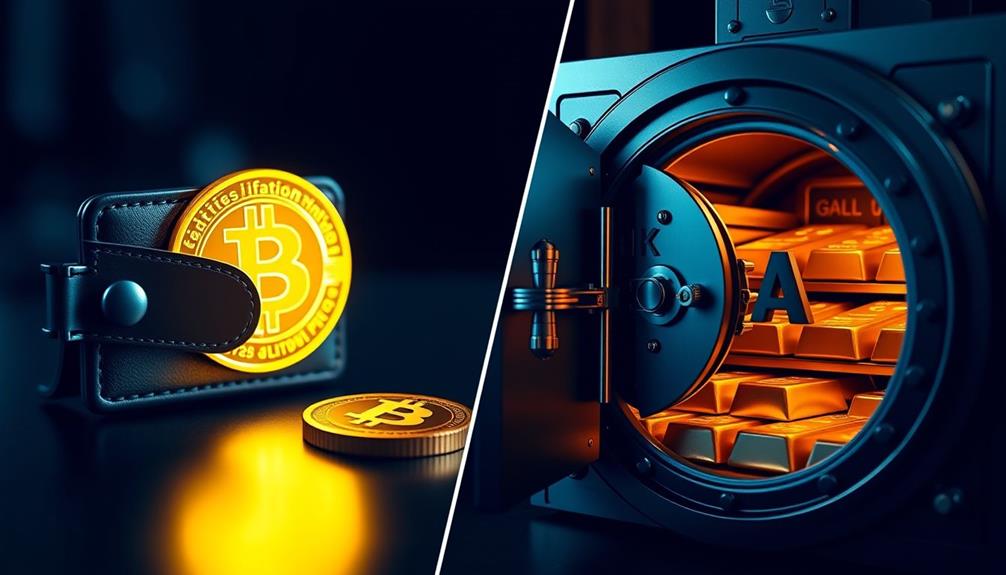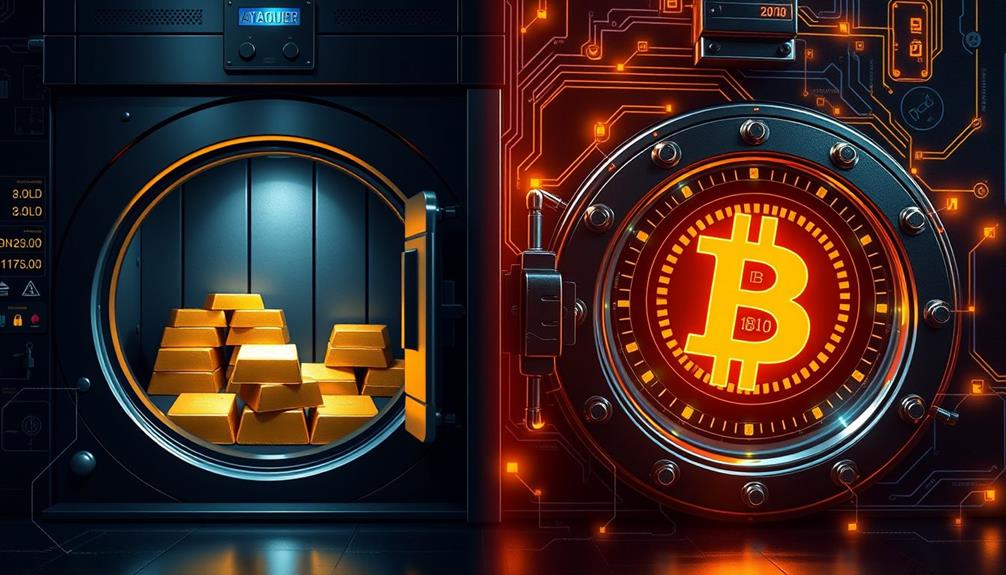When considering Bitcoin IRAs versus Gold IRAs, your choice hinges on risk and reward. Bitcoin IRAs can offer explosive growth due to their inherent volatility, having surged greatly in recent years. However, this comes with high risks and fluctuating prices that might leave you anxious. On the other hand, Gold IRAs provide stability and a long-standing reputation as a safe haven for wealth preservation. They tend to be less volatile, making them a more conservative choice. Your investment strategy can benefit from understanding both options and how they align with your financial goals. Other insights await you to make the best choice.
Key Takeaways
- Bitcoin IRAs offer higher potential returns due to significant price volatility, but come with increased risk and uncertainty compared to Gold IRAs.
- Gold IRAs provide a stable store of value, historically performing well during economic downturns, making them a safer long-term investment option.
- The market cap of Bitcoin is growing rapidly, reaching approximately $1.3 trillion in 2024, indicating strong future growth potential.
- Gold's well-established regulatory framework and lower fees contribute to a more predictable investment environment, enhancing its appeal for conservative investors.
- Combining both Bitcoin and Gold IRAs can diversify portfolios, balancing the high-risk potential of Bitcoin with the stability of gold.
Understanding Bitcoin and Gold

When you think about investments, gold and Bitcoin often come to mind for their distinct characteristics. Gold has served as a reliable store of value for millennia, thriving during economic turmoil, such as when its price nearly tripled from 2008 to 2011. This long-standing stability is what makes gold a safe haven asset for those wary of market fluctuations.
On the other hand, Bitcoin, created in response to the 2008 financial crisis, introduces a new concept of value in the form of digital currency. With a capped supply of 21 million units, Bitcoin mirrors gold's limited availability, establishing its own digital scarcity.
However, the two assets differ markedly in performance and risk. As of 2024, Bitcoin's market capitalization stands at around $1.3 trillion, while gold's is over $7.5 trillion, reflecting gold's established dominance.
Bitcoin's price has shown considerable volatility, swinging from about $65,000 in November 2021 to roughly $15,500 just a year later. This speculative nature attracts risk-tolerant investors looking for higher returns, while gold remains a steadfast choice for those prioritizing stability in their investment portfolios.
Investment Dynamics of Bitcoin IRAs

When considering Bitcoin IRAs, you need to weigh the investment risks against the potential tax advantages.
These accounts offer unique diversification opportunities, but the high volatility of Bitcoin can complicate your investment strategy.
It's essential to avoid gold IRA scams by thoroughly researching companies and verifying their legitimacy.
Understanding these dynamics will help you make informed decisions about your retirement portfolio.
Investment Risks Comparison
Although Bitcoin IRAs can offer high potential returns, the investment risks associated with them are significant and shouldn't be underestimated. The price volatility of Bitcoin is a primary concern, with dramatic fluctuations ranging from $65,000 in November 2021 to as low as $15,500 a year later. This instability can lead to substantial losses, making Bitcoin IRAs a riskier choice compared to Gold IRAs, which historically maintain their value and are less prone to sudden market swings.
In addition, investing in Gold serves as a hedge against inflation and economic uncertainty, making it a more reliable choice for long-term financial security and effective diversification of retirement portfolio.
Additionally, transaction fees for Bitcoin IRAs, ranging from 1% to 3.5%, can further erode your potential returns, whereas Gold IRAs typically have lower fees, enhancing their cost-effectiveness. Regulatory risks also loom large for Bitcoin IRAs due to the constantly evolving legal landscape surrounding cryptocurrencies, potentially affecting asset availability and value stability.
In contrast, Gold has a well-established regulatory framework, offering more predictability. Given their speculative nature, financial advisors often recommend that Bitcoin IRAs only comprise 2% to 5% of your total portfolio, while Gold can be a more substantial component for effective risk management and wealth preservation.
Tax Advantages Overview
Investing in a Bitcoin IRA not only presents unique risks but also offers notable tax advantages that can enhance your retirement strategy.
With a Bitcoin IRA, you benefit from tax-deferred growth, similar to traditional IRAs. This means you can defer taxes on your gains until you withdraw funds, allowing your investment to compound more effectively over time.
If you choose a Roth Bitcoin IRA, you can enjoy tax-free withdrawals after you reach age 59.5, which means you won't face future tax liabilities on your earnings.
It's essential to understand that capital gains taxes apply to Bitcoin sales within traditional IRAs. The IRS classifies Bitcoin as non-currency personal property, so any gains realized upon selling it in an IRA are subject to taxation, much like stocks.
As a result, being aware of the tax implications when liquidating your assets is vital.
Diversification Opportunities Explained
As you explore diversification opportunities, Bitcoin IRAs stand out by allowing you to invest in a broad array of cryptocurrencies, not just Bitcoin. This flexibility lets you tap into over 20,000 alternative assets, greatly enhancing your portfolio's growth potential compared to a Gold IRA, which usually restricts investments to gold and other precious metals.
Additionally, like Gold IRAs offer tax advantages, Bitcoin IRAs can provide tax-deferred growth, making them an attractive option for savvy investors looking to maximize their returns.
The cryptocurrency market, with Bitcoin's market cap reaching approximately $1.3 trillion in 2024, offers substantial growth potential, especially in bullish conditions. While gold provides stability, it pales in comparison to Bitcoin's ability to yield higher returns in a rapidly changing market.
However, keep in mind that Bitcoin's volatility—like its dramatic price drops from $65,000 to $15,500 within a year—introduces a risk-reward dynamic. If managed correctly, this volatility can enhance your portfolio performance.
Additionally, investing in Bitcoin through a self-directed IRA allows you to benefit from tax advantages, such as tax-deferred growth or tax-free withdrawals. This can further amplify your returns compared to taxable gold investments.
Embracing these diversification opportunities can position you for considerable wealth growth.
Investment Dynamics of Gold IRAs

Gold IRAs offer a compelling way to incorporate physical gold and other precious metals into your retirement portfolio. By investing in a gold IRA, you can benefit from gold's historical stability and its status as a hedge against inflation. The IRS allows various forms of gold, including bullion and coins, as long as they meet specific purity standards, such as 99.5% for gold bullion.
One of the key investment dynamics of gold IRAs is their ability to provide diversification. Gold has traditionally shown low correlation with stock market performance, making it an effective tool to reduce portfolio volatility, especially during economic downturns. When markets are shaky, gold often shines, as evidenced by its nearly 25% price surge in 2020 amid the uncertainty caused by the COVID-19 pandemic.
With a market capitalization exceeding $7.5 trillion, gold remains a significant safe haven asset, dwarfing Bitcoin's market. This resilience during crises and its potential for long-term growth make gold IRAs an attractive option for those looking to secure their financial future while protecting against inflation and economic instability.
Comparing Risk Factors

When weighing the risk factors of Bitcoin IRAs against Gold IRAs, it's crucial to recognize the stark differences in volatility. Bitcoin's price can swing dramatically, with values plummeting from $65,000 in November 2021 to as low as $15,500 by November 2022. This level of fluctuation illustrates the speculative risks associated with Bitcoin IRAs, making them potentially volatile investments.
On the other hand, gold has a long-standing reputation for stability, often serving as a safe haven during economic downturns. Its lower volatility tends to mitigate risk for long-term investors, making a gold IRA a more conservative choice.
Additionally, the fees associated with Bitcoin IRAs can be quite high—averaging between 1% to 3.5% for transactions and up to 25% for setup fees—potentially eroding your overall returns. In contrast, gold IRAs generally feature lower fees.
Regulatory scrutiny around cryptocurrencies adds another layer of risk for Bitcoin IRAs, while gold operates within a well-established regulatory framework. Coupled with the lack of historical performance data for Bitcoin, these risk factors underscore the uncertainties involved in cryptocurrency investments compared to the more predictable landscape of gold.
Historical Performance Analysis

When you look at historical performance, gold shines with its steady stability, often rising during uncertain times.
In contrast, Bitcoin showcases remarkable volatility, with explosive growth that can lead to significant gains—or losses.
Understanding these trends can help you assess which investment aligns better with your financial goals.
Gold's Historical Stability
Throughout history, gold has proven to be a stable store of value, enduring economic downturns and market volatility with remarkable resilience. For thousands of years, investors have turned to gold as an effective hedge against financial uncertainty. From 2008 to 2011, you'd have seen gold prices nearly triple, showcasing its role as a safe haven asset during turbulent times.
Over the past two decades, gold's performance has reflected lower volatility compared to many equities and cryptocurrencies, making it a reliable long-term investment option. As of September 2024, gold prices have continued to show resilience, reporting over 3% growth from the previous month. This trend underscores ongoing investor confidence in gold's stability.
With a market cap exceeding $7.5 trillion, gold stands considerably larger than Bitcoin's market cap, solidifying its established role in global finance as a dependable asset.
In a world where market conditions can change rapidly, gold remains a trusted choice for those looking to protect and grow their wealth, ensuring that you can navigate economic challenges with a stable store of value at your side.
Bitcoin's Volatile Growth
How has Bitcoin's rapid rise and fall shaped its reputation as an investment? Bitcoin's volatile growth is a double-edged sword; it can lead to substantial profits or devastating losses. From June 2020, Bitcoin's price skyrocketed from around $9,600 to approximately $60,000 by early 2024, showcasing a staggering 575% increase.
However, this journey isn't without its bumps—just consider the drop from $65,000 in November 2021 to a low of $15,500 in November 2022. Such fluctuations make Bitcoin a compelling yet risky option for your retirement accounts.
As more people become interested in cryptocurrencies, with 17% of U.S. adults reportedly involved, Bitcoin's market capitalization surged to nearly $1.3 trillion in 2024. This growth reflects its emergence as a significant player in financial services.
Yet, remember that extreme price swings often stem from market sentiment, regulatory scrutiny, and broader economic conditions. This unpredictability can make it a thrilling but dangerous asset for investors.
Comparative Historical Returns
Over the past decade, Bitcoin's historical returns have captured the attention of investors, showcasing its potential for remarkable growth. When you compare the historical performance of Bitcoin and gold, it's clear that Bitcoin often takes the lead in wealth generation.
Here's a look at their comparative historical returns:
| Investment | Price Change (2008-2021) | Annualized Return |
|---|---|---|
| Bitcoin | +575% | >200% |
| Gold | +200% | ~10% |
Bitcoin's price surged from about $9,600 in June 2020 to around $60,000 by late 2021, illustrating its explosive growth. On the other hand, gold has shown steady performance, nearly tripling from 2008 to 2011, proving itself as a reliable store of wealth. While Bitcoin's volatility can be intimidating, its annualized return since 2009 greatly outpaces gold's.
In times of economic uncertainty and heightened inflation, Bitcoin's performance stands out, demonstrating its potential to explode your wealth faster than gold. Understanding these comparative historical returns can help you make an informed decision for your investment strategy.
Tax Benefits and Implications

Maximizing your investment potential in retirement means understanding the tax benefits and implications of both Bitcoin IRAs and Gold IRAs. Both types offer significant tax advantages, allowing your investments to grow without immediate taxation.
With traditional IRAs, you can make tax-deferred contributions, while Roth IRAs provide tax-free withdrawals in retirement. A major benefit is that you won't pay capital gains tax when selling assets within these IRAs until you withdraw funds, which can enhance your wealth compounding over time.
For 2023, you can contribute up to $6,500 to either IRA (or $7,500 if you're 50 or older), maximizing your tax-advantaged contributions.
However, keep in mind that both IRAs require minimum distributions (RMDs) starting at age 72, influencing your tax strategy as you prepare for retirement income.
Additionally, investment flexibility varies: Bitcoin IRAs allow you to diversify across various cryptocurrencies, while Gold IRAs focus on physical gold and related assets. This difference can impact your overall tax implications based on how each asset performs and is eventually sold.
Choosing the Right Provider

Selecting the right provider for your Bitcoin IRA is vital for guaranteeing a smooth and successful investment journey. When you're diving into the world of cryptocurrency IRAs, comparing fee structures is key.
Setup fees can vary dramatically, from 0% to 25%, while ongoing maintenance fees typically hover around 1% per year. Look for providers that present solid financial offers and a diverse range of cryptocurrencies if you want to broaden your investment beyond just Bitcoin.
Security is another important factor. Confirm your chosen provider utilizes advanced safety measures like cold storage and multi-signature wallets to protect your assets.
It's also important to assess the minimum investment requirements, as these can range from no minimum balance with some providers, like Swan Bitcoin, to $20,000 or more with others.
Lastly, evaluate the level of customer support and educational resources available. A provider that offers robust support can make a significant difference in your investment experience and help you make informed decisions as you navigate your cryptocurrency IRA.
Take your time, do your research, and choose the right provider to set yourself up for success.
Diversification Strategies

When you think about diversification strategies, consider how different asset classes can work together to balance your portfolio.
By allocating a small portion to Bitcoin alongside a Gold IRA, you can manage risk while tapping into the growth potential of cryptocurrencies.
This combination not only offers variety but also helps shield your investments from market volatility.
Asset Class Variety
Diversifying your investment portfolio is essential for managing risk and enhancing potential returns, and choosing between a Bitcoin IRA and a Gold IRA offers distinct opportunities.
With Bitcoin IRAs, you can invest in over 20,000 cryptocurrencies, providing a wider range of asset class options compared to Gold IRAs, which typically focus solely on gold. This variety allows for more effective diversification strategies, helping you to spread risk across different assets.
Consider the following points when evaluating your options:
- Broader Diversification: Bitcoin allows access to numerous cryptocurrencies, while gold remains a single asset class.
- Volatility vs. Stability: Bitcoin's price can fluctuate wildly, presenting high-risk, high-reward opportunities, while gold offers lower volatility and serves as a safe haven.
- Historical Performance: Bitcoin has shown remarkable growth, while gold maintains stability, often hedging against inflation.
- Tax Advantages: Both types of IRAs offer tax-advantaged growth, but the tax implications can vary considerably.
Ultimately, understanding these asset class characteristics will help you make a more informed decision tailored to your financial goals and risk tolerance.
Risk Management Approaches
Effective risk management is essential for any investment strategy, and combining different asset classes can greatly enhance your portfolio's resilience. By utilizing diversification strategies, you can reduce investment risk considerably. Allocating between 2% to 5% of your total portfolio in cryptocurrencies like Bitcoin can boost potential returns while managing volatility.
| Asset Class | Risk Level | Return Potential |
|---|---|---|
| Bitcoin IRAs | High | Very High |
| Gold | Low | Moderate |
| Stocks | Moderate | High |
Investing in a mix of asset classes, such as Bitcoin IRAs and traditional assets like gold, helps mitigate risks associated with market fluctuations. Historical data shows gold as a stable long-term investment and a hedge against economic downturns, while Bitcoin's inherent volatility may offer high returns.
To further improve your risk management, choose reputable providers for both Bitcoin and Gold IRAs to guarantee security and compliance. Don't forget to regularly monitor and rebalance your asset allocations. This way, you can maintain your desired risk levels and effectively leverage diversification strategies for peak portfolio performance.
Security Measures for Investments

Security is paramount in the world of investments, especially when comparing Bitcoin IRAs and Gold IRAs. Both investment types have unique security measures that you should consider before committing your funds.
For Bitcoin IRAs, advanced security protocols are vital due to the digital nature of the assets. Reputable custodians typically implement:
- Cold storage for offline asset protection
- Multi-signature wallets to enhance transaction security
- Insurance against potential losses to safeguard your investment
- Strong due diligence practices to guarantee transparency in custody
On the other hand, Gold IRAs involve physical assets stored in secure, insured vaults. This provides a different kind of security, protecting your gold from physical theft or damage.
While Bitcoin's volatility demands heightened security protocols, gold's stable historical presence offers a more traditional approach to safeguarding your wealth.
Ultimately, whether you choose a Bitcoin IRA or a Gold IRA, make certain to select custodians with proven security histories to mitigate risks. Your investment's security is essential, so don't overlook these vital measures when deciding where to allocate your wealth.
Future Outlook and Trends

As you consider the future of your investments, it's important to look at the trends shaping Bitcoin and Gold IRAs. Bitcoin and other cryptocurrencies have shown remarkable growth, with market caps reaching approximately $1.3 trillion in 2024. However, this rapid appreciation comes with significant volatility.
You might be drawn to Bitcoin's potential for rapid wealth accumulation, having seen its price soar from around $9,600 in June 2020 to nearly $60,000 in 2024. Still, remember that this high reward also carries higher risks.
On the other hand, the precious metals IRA has consistently provided stability. Gold's ability to triple in value from 2008 to 2011 illustrates its resilience, especially during economic downturns.
The daily trading volume in gold markets far exceeds that of Bitcoin, indicating greater liquidity and trust among conservative investors.
Looking ahead, regulatory developments could enhance Bitcoin's market position, drawing even more institutional interest. As an investor, you should weigh these factors carefully.
An IRA allows you to diversify your portfolio, balancing the high-risk potential of Bitcoin with the steady reliability of gold. Ultimately, your investment strategy should align with your risk tolerance and financial goals.
Frequently Asked Questions
Is It Better to Invest in Gold or Bitcoin?
It depends on your investment goals. If you prefer stability and low volatility, gold's a solid choice. If you're open to high risk and potential high returns, Bitcoin might suit you better. Choose wisely!
What Is the Downside of a Gold Ira?
Investing in a Gold IRA can feel like maneuvering through a maze. You face higher fees, potential liquidity issues, and the complexities of storage and insurance. These factors can weigh heavily on your overall investment returns.
Is Bitcoin IRA Worth It?
You'll find a Bitcoin IRA offers potential for significant returns, but it also comes with high fees and volatility. If you're comfortable with the risks, a small allocation could be worth considering for diversification.
What Coin Will Skyrocket in 2024?
"Fortune favors the bold." In 2024, keep an eye on Bitcoin and Ethereum. Their predicted price surges might just make your investment dreams come true, while altcoins like Solana and Cardano could surprise you too.
Conclusion
In the end, deciding between a Bitcoin IRA and a Gold IRA is like choosing between a rocket and a sturdy ship; both have their unique advantages. If you're looking for explosive growth, Bitcoin might be your best bet, while gold offers stability in turbulent times. Ultimately, it's about your risk tolerance and investment goals. Whichever path you choose, diversifying your portfolio can help you navigate the financial seas more smoothly. Happy investing!










